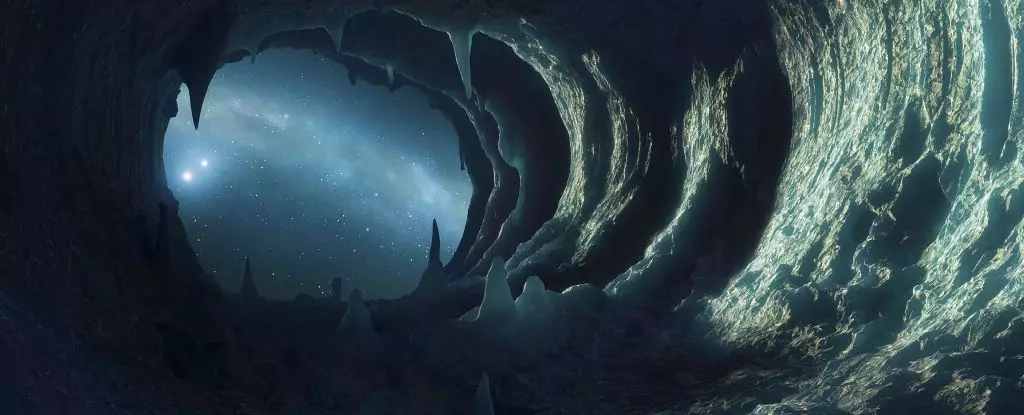For a long time, scientists believed that water in the distant reaches of space was nothing more than an amorphous, glassy substance—an unstructured jumble of molecules frozen in place. This assumption stemmed from the idea that space’s extreme cold lacked the energy necessary to facilitate the formation of orderly crystals. However, recent breakthroughs in computational simulations and experimental analysis challenge this simplistic view, suggesting that space ice might be far more organized than previously thought. Instead of being entirely disordered, cosmic ice appears to harbor tiny crystalline structures—just nanometers across—embedded within an otherwise amorphous matrix. This revelation is a profound revision of our understanding of the universe’s most common form of water and could influence models of planetary formation, galaxy evolution, and the movement of matter across cosmic scales.
Crystals in the Void: Challenging Assumptions About Space Ice
Historically, the scientific consensus held that the harsh conditions of space—extremely low temperatures and negligible energy—prevented the formation of crystalline ice. Instead, it was assumed that water froze directly from vaporized states into amorphous, glass-like solids. This view placed space ice in the same category as a frozen snapshot—disordered, lacking the regular patterns observed in terrestrial snowflakes or glaciers. But recent research, combining detailed computer simulations with laboratory experiments that mimic cosmic environments, points to a nuanced reality. The findings indicate that a significant portion of cosmic ice—approximately 20 percent—may actually consist of tiny crystalline domains, even in the cold depths of space. These nanocrystals, despite their minuscule size, could have outsized effects on how ice interacts with photons, influences the chemistry of interstellar dust, and serves as nucleation sites for planet formation.
Experimentation and Simulation: Peering Into the Atomic Fabric of Space Ice
The team behind this discovery employed sophisticated modeling, freezing virtual water molecules to extreme cold temperatures—around -120°C (-184°F)—controlling variables like freezing rate to observe crystal formation. Different techniques were used to simulate processes typical of space: vapor deposition onto cold surfaces, akin to water vapor freezing directly onto cosmic dust particles, and crushing ice at ultralow temperatures to generate dense amorphous forms. Their simulations revealed that when warmed, these forms exhibited signs of partial crystallinity, indicating that order was preserved at the atomic level even after initial disorderly freezing processes. Moreover, experimental results showed that water molecules retain a “memory” of their crystalline origins, an insight suggesting that tiny crystalline patches could persist amidst the amorphous sea. This evidence underscores that even in the bleak darkness of space, water molecules are capable of forming structured regions—contradicting the long-held notion of space ice as purely amorphous.
Implications for Cosmic Evolution and Material Science
Understanding that space ice contains crystalline patches reshapes our models of how celestial bodies evolve. Crystalline regions in icy bodies could affect how they absorb and scatter radiation, influencing thermal properties and chemical reactions on planetary surfaces or within comets. These crystals could also serve as scaffolds for complex chemistry, perhaps even facilitating the assembly of organic molecules—ingredients vital for life. In a broader context, this insight extends to the study of amorphous materials beyond space ice. The fact that tiny crystalline domains can survive within disordered matrices informs material science, especially in industries employing glasses and amorphous solids. Recognizing that order can exist on the nanoscale within seemingly disordered structures opens avenues for engineering advanced materials with tailored properties—be it in electronics, photonics, or nanotechnology.
The Future of Cosmic Ice Research: New Horizons in Cosmology
This paradigm shift invites a reevaluation of numerous astrophysical processes. What other molecules in space might harbor hidden structures? How do tiny crystalline regions influence the lifecycle of interstellar dust or the formation of planets and moons? More importantly, this discovery beckons us to develop more refined observational techniques—such as advanced spectroscopy and space-based imaging—to detect these minute crystals directly in cosmic environments. As our understanding deepens, we may discover that the universe is far more intricate and ordered at the microscopic level than our coarse observations have suggested. The ongoing quest to decode the universe’s frozen secrets promises a future where our comprehension of cosmic matter is richer, more detailed, and undeniably more fascinating.
Unquestionably, the revelation of crystalline structures within space ice marks a watershed moment—one that could redefine the foundational principles of astrochemistry and cosmology. Far from being just a frozen, featureless expanse, space’s ice may be a nuanced tapestry of order and chaos, waiting to reveal more of its hidden complexity.


Leave a Reply